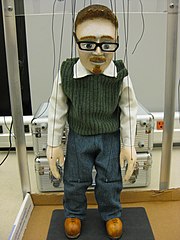Special Division for Advance Robotics (Bambang Achdiat)
Written by Quantum Study Club on 08.12

Advance Artificial Intelligence
Robotics
From Wikipedia, the free encyclopedia

Robotics is the science and technology of robots, and their design, manufacture, and application.[1] Roboticists also study electronics, mechanics and software.[2]
Contents |
Origins
- See also: History of robots and Robot
Stories of artificial helpers and companions and attempts to create them have a long history, but fully autonomous machines only appeared in the 20th century. The first digitally operated and programmable robot, the Unimate, was installed in 1961 to lift hot pieces of metal from a die casting machine and stack them. Today, commercial and industrial robots are in widespread use performing jobs more cheaply or with greater accuracy and reliability than humans. They are also employed for jobs which are too dirty, dangerous or dull to be suitable for humans. Robots are widely used in manufacturing, assembly and packing, transport, earth and space exploration, surgery, weaponry, laboratory research, and mass production of consumer and industrial goods.[3]
| Date | Significance | Robot Name | Inventor | |
|---|---|---|---|---|
| First century A.D. and earlier | Descriptions of more than 100 machines and automata, including a fire engine, a wind organ, a coin-operated machine, and a steam-powered engine, in Pneumatica and Automata by Heron of Alexandria | Ctesibius of Alexandria, Philo of Byzantium, Heron of Alexandria, and others | ||
| 1206 | First programmable humanoid robots | Boat with four robotic musicians | Al-Jazari | |
| c. 1495 | Designs for a humanoid robot | Mechanical knight | Leonardo da Vinci | |
| 1738 | Mechanical duck that was able to eat, flap its wings, and excrete | Digesting Duck | Jacques de Vaucanson | |
| 1800s | Japanese mechanical toys that served tea, fired arrows, and painted | Karakuri toys | Hisashige Tanaka | |
| 1921 | First fictional automatons called "robots" appear in the play R.U.R. | Rossum's Universal Robots | Karel Čapek | |
| 1930s | Humanoid robot exhibited at the 1939 and 1940 World's Fairs | Elektro | Westinghouse Electric Corporation | |
| 1948 | Simple robots exhibiting biological behaviors[4] | Elsie and Elmer | William Grey Walter | |
| 1956 | First commercial robot, from the Unimation company founded by George Devol and Joseph Engelberger, based on Devol's patents[5] | Unimate | George Devol | |
| 1961 | First installed industrial robot | Unimate | George Devol | |
| 1963 | First palletizing robot[6] | Palletizer | Fuji Yusoki Kogyo | |
| 1973 | First robot with six electromechanically driven axes | Famulus | KUKA Robot Group | |
| 1975 | Programmable universal manipulation arm, a Unimation product | PUMA | Victor Scheinman |
According to the Oxford English Dictionary, the word robotics was first used in print by Isaac Asimov, in his science fiction short story "Liar!", published in May 1941 in Astounding Science Fiction. Asimov was unaware that he was coining the term; since the science and technology of electrical devices is electronics, he assumed robotics already referred to the science and technology of robots.[7] The word robot was introduced to the public by Czech writer Karel Čapek in his play R.U.R. (Rossum's Universal Robots), which premiered in 1921.[8]
Components of robots
Structure
The structure of a robot is usually mostly mechanical and can be called a kinematic chain (its functionality being similar to the skeleton of the human body). The chain is formed of links (its bones), actuators (its muscles) and joints which can allow one or more degrees of freedom. Most contemporary robots use open serial chains in which each link connects the one before to the one after it. These robots are called serial robots and often resemble the human arm. Some robots, such as the Stewart platform, use a closed parallel kinematical chain. Other structures, such as those that mimic the mechanical structure of humans, various animals and insects, are comparatively rare. However, the development and use of such structures in robots is an active area of research (e.g. biomechanics). Robots used as manipulators have an end effector mounted on the last link. This end effector can be anything from a welding device to a mechanical hand used to manipulate the environment.
Actuation
Actuators are the "muscles" of a robot, the parts which convert stored energy into movement. By far the most popular actuators are electric motors, but there are many others, powered by electricity, chemicals, and compressed air.
- Motors: The vast majority of robots use electric motors, including brushed and brushless DC motors.
- Stepper motors: As the name suggests, stepper motors do not spin freely like DC motors; they rotate in discrete steps, under the command of a controller. This makes them easier to control, as the controller knows exactly how far they have rotated, without having to use a sensor. Therefore they are used on many robots and CNC machines.
- Piezo motors: A recent alternative to DC motors are piezo motors or ultrasonic motors. These work on a fundamentally different principle, whereby tiny piezoceramic elements, vibrating many thousands of times per second, cause linear or rotary motion. There are different mechanisms of operation; one type uses the vibration of the piezo elements to walk the motor in a circle or a straight line.[9] Another type uses the piezo elements to cause a nut to vibrate and drive a screw. The advantages of these motors are nanometer resolution, speed and available force for their size.[10] These motors are already available commercially, and being used on some robots.[11][12]
- Air muscles: The air muscle is a simple yet powerful device for providing a pulling force. When inflated with compressed air, it contracts by up to 40% of its original length. The key to its behavior is the braiding visible around the outside, which forces the muscle to be either long and thin, or short and fat. Since it behaves in a very similar way to a biological muscle, it can be used to construct robots with a similar muscle/skeleton system to an animal.[13] For example, the Shadow robot hand uses 40 air muscles to power its 24 joints.
- Electroactive polymers: Electroactive polymers are a class of plastics which change shape in response to electrical stimulation.[14] They can be designed so that they bend, stretch or contract, but so far there are no EAPs suitable for commercial robots, as they tend to have low efficiency or are not robust.[15] Indeed, all of the entrants in a recent competition to build EAP powered arm wrestling robots, were beaten by a 17 year old girl.[16] However, they are expected to improve in the future, where they may be useful for microrobotic applications.[17]
- Elastic nanotubes: These are a promising, early-stage experimental technology. The absence of defects in nanotubes enables these filaments to deform elastically by several percent, with energy storage levels of perhaps 10J per cu cm for metal nanotubes. Human biceps could be replaced with an 8mm diameter wire of this material. Such compact "muscle" might allow future robots to outrun and outjump humans.[18]
Manipulation
Robots which must work in the real world require some way to manipulate objects; pick up, modify, destroy or otherwise have an effect. Thus the 'hands' of a robot are often referred to as end effectors,[19] while the arm is referred to as a manipulator.[20] Most robot arms have replaceable effectors, each allowing them to perform some small range of tasks. Some have a fixed manipulator which cannot be replaced, while a few have one very general purpose manipulator, for example a humanoid hand.
- Mechanical Grippers: One of the most common effectors is the gripper. In its simplest manifestation it consists of just two fingers which can open and close to pick up and let go of a range of small objects. See End effectors.
- Vacuum Grippers: Pick and place robots for electronic components and for large objects like car windscreens, will often use very simple vacuum grippers. These are very simple astrictive [21] devices, but can hold very large loads provided the prehension surface is smooth enough to ensure suction.
- General purpose effectors: Some advanced robots are beginning to use fully humanoid hands, like the Shadow Hand and the Schunk hand.[22] These highly dexterous manipulators, with as many as 20 degrees of freedom and hundreds of tactile sensors[23]
For the definitive guide to all forms of robot endeffectors, their design and usage consult the book "Robot Grippers".[24]
Locomotion
Rolling Robots
For simplicity, most mobile robots have four wheels. However, some researchers have tried to create more complex wheeled robots, with only one or two wheels.
- Two-wheeled balancing: While the Segway is not commonly thought of as a robot, it can be thought of as a component of a robot. Several real robots do use a similar dynamic balancing algorithm, and NASA's Robonaut has been mounted on a Segway.[25]
- Ballbot: Carnegie Mellon University researchers have developed a new type of mobile robot that balances on a ball instead of legs or wheels. "Ballbot" is a self-contained, battery-operated, omnidirectional robot that balances dynamically on a single urethane-coated metal sphere. It weighs 95 pounds and is the approximate height and width of a person. Because of its long, thin shape and ability to maneuver in tight spaces, it has the potential to function better than current robots can in environments with people.[26]
- Track Robot: Another type of rolling robot is one that has tracks, like NASA's Urban Robot, Urbie.[27]
Walking Robots

Walking is a difficult and dynamic problem to solve. Several robots have been made which can walk reliably on two legs, however none have yet been made which are as robust as a human. Typically, these robots can walk well on flat floors, and can occasionally walk up stairs. None can walk over rocky, uneven terrain. Some of the methods which have been tried are:
- ZMP Technique: The Zero Moment Point (ZMP) is the algorithm used by robots such as Honda's ASIMO. The robot's onboard computer tries to keep the total inertial forces (the combination of earth's gravity and the acceleration and deceleration of walking), exactly opposed by the floor reaction force (the force of the floor pushing back on the robot's foot). In this way, the two forces cancel out, leaving no moment (force causing the robot to rotate and fall over).[28] However, this is not exactly how a human walks, and the difference is quite apparent to human observers, some of whom have pointed out that ASIMO walks as if it needs the lavatory.[29][30][31] ASIMO's walking algorithm is not static, and some dynamic balancing is used (See below). However, it still requires a smooth surface to walk on.
- Hopping: Several robots, built in the 1980s by Marc Raibert at the MIT Leg Laboratory, successfully demonstrated very dynamic walking. Initially, a robot with only one leg, and a very small foot, could stay upright simply by hopping. The movement is the same as that of a person on a pogo stick. As the robot falls to one side, it would jump slightly in that direction, in order to catch itself.[32] Soon, the algorithm was generalised to two and four legs. A bipedal robot was demonstrated running and even performing somersaults.[33] A quadruped was also demonstrated which could trot, run, pace and bound.[34] For a full list of these robots, see the MIT Leg Lab Robots page.
- Dynamic Balancing: A more advanced way for a robot to walk is by using a dynamic balancing algorithm, which is potentially more robust than the Zero Moment Point technique, as it constantly monitors the robot's motion, and places the feet in order to maintain stability.[35] This technique was recently demonstrated by Anybots' Dexter Robot,[36] which is so stable, it can even jump.[37]
- Passive Dynamics: Perhaps the most promising approach utilises passive dynamics where the momentum of swinging limbs is used for greater efficiency. It has been shown that totally unpowered humanoid mechanisms can walk down a gentle slope, using only gravity to propel themselves. Using this technique, a robot need only supply a small amount of motor power to walk along a flat surface or a little more to walk up a hill. This technique promises to make walking robots at least ten times more efficient than ZMP walkers, like ASIMO.[38][39]
Other methods of locomotion
- Flying: A modern passenger airliner is essentially a flying robot, with two humans to manage it. The autopilot can control the plane for each stage of the journey, including takeoff, normal flight and even landing.[40] Other flying robots are uninhabited, and are known as Unmanned Aerial Vehicles (UAVs). They can be smaller and lighter without a human pilot onboard, and fly into dangerous territory for military surveillance missions. Some can even fire on targets under command. UAVs are also being developed which can fire on targets automatically, without the need for a command from a human. However these robots are unlikely to see service in the foreseeable future because of the morality issues involved. Other flying robots include cruise missiles, the Entomopter and the Epson micro helicopter robot.
- Snaking: Several snake robots have been successfully developed. Mimicking the way real snakes move, these robots can navigate very confined spaces, meaning they may one day be used to search for people trapped in collapsed buildings.[41] The Japanese ACM-R5 snake robot[42] can even navigate both on land and in water.[43]
- Skating: A small number of skating robots have been developed, one of which is a multi-mode walking and skating device, Titan VIII. It has four legs, with unpowered wheels, which can either step or roll.[44] Another robot, Plen, can use a miniature skateboard or rollerskates, and skate across a desktop.[45]
- Swimming: It is calculated that when swimming some fish can achieve a propulsive efficiency greater than 90%.[46] Furthermore, they can accelerate and manoeuver far better than any man-made boat or submarine, and produce less noise and water disturbance. Therefore, many researchers studying underwater robots would like to copy this type of locomotion.[47] Notable examples are the Essex University Computer Science Robotic Fish,[48] and the Robot Tuna built by the Institute of Field Robotics, to analyse and mathematically model thunniform motion.[49]
Human interaction

If robots are to work effectively in homes and other non-industrial environments, the way they are instructed to perform their jobs, and especially how they will be told to stop will be of critical importance. The people who interact with them may have little or no training in robotics, and so any interface will need to be extremely intuitive. Science fiction authors also typically assume that robots will eventually communicate with humans by talking, gestures and facial expressions, rather than a command-line interface. Although speech would be the most natural way for the human to communicate, it is quite unnatural for the robot. It will be quite a while before robots interact as naturally as the fictional C3P0.
- Speech recognition: Interpreting the continuous flow of sounds coming from a human (speech recognition), in real time, is a difficult task for a computer, mostly because of the great variability of speech. The same word, spoken by the same person may sound different depending on local acoustics, volume, the previous word, whether or not the speaker has a cold, etc.. It becomes even harder when the speaker has a different accent.[50] Nevertheless, great strides have been made in the field since Davis, Biddulph, and Balashek designed the first "voice input system" which recognized "ten digits spoken by a single user with 100% accuracy" in 1952.[51] Currently, the best systems can recognise continuous, natural speech, up to 160 words per minute, with an accuracy of 95%.[52]
- Gestures: One can imagine, in the future, explaining to a robot chef how to make a pastry, or asking directions from a robot police officer. On both of these occasions, making hand gestures would aid the verbal descriptions. In the first case, the robot would be recognising gestures made by the human, and perhaps repeating them for confirmation. In the second case, the robot police officer would gesture to indicate "down the road, then turn right". It is quite likely that gestures will make up a part of the interaction between humans and robots.[53] A great many systems have been developed to recognise human hand gestures.[54]
- Facial expression: Facial expressions can provide rapid feedback on the progress of a dialog between two humans, and soon it may be able to do the same for humans and robots. A robot should know how to approach a human, judging by their facial expression and body language. Whether the person is happy, frightened or crazy-looking affects the type of interaction expected of the robot. Likewise, a robot like Kismet can produce a range of facial expressions, allowing it to have meaningful social exchanges with humans.[55]
- Personality: Many of the robots of science fiction have personality, and that is something which may or may not be desirable in the commercial robots of the future.[56] Nevertheless, researchers are trying to create robots which appear to have a personality:[57][58] i.e. they use sounds, facial expressions and body language to try to convey an internal state, which may be joy, sadness or fear. One commercial example is Pleo, a toy robot dinosaur, which can exhibit several apparent emotions.[59]
Control
The mechanical structure of a robot must be controlled to perform tasks. The control of a robot involves three distinct phases - perception, processing and action (robotic paradigms). Sensors give information about the environment or the robot itself (e.g. the position of its joints or its end effector). This information is then processed to calculate the appropriate signals to the actuators (motors) which move the mechanical structure.
The processing phase can range in complexity. At a reactive level, it may translate raw sensor information directly into actuator commands. Sensor fusion may first be used to estimate parameters of interest (e.g. the position of the robot's gripper) from noisy sensor data. An immediate task (such as moving the gripper in a certain direction) is inferred from these estimates. Techniques from control theory convert the task into commands that drive the actuators.
At longer time scales or with more sophisticated tasks, the robot may need to build and reason with a "cognitive" model. Cognitive models try to represent the robot, the world, and how they interact. Pattern recognition and computer vision can be used to track objects. Mapping techniques can be used to build maps of the world. Finally, motion planning and other artificial intelligence techniques may be used to figure out how to act. For example, a planner may figure out how to achieve a task without hitting obstacles, falling over, etc.
Control systems may also have varying levels of autonomy. Direct interaction is used for haptic or tele-operated devices, and the human has nearly complete control over the robot's motion. Operator-assist modes have the operator commanding medium-to-high-level tasks, with the robot automatically figuring out how to achieve them. An autonomous robot may go for extended periods of time without human interaction. Higher levels of autonomy do not necessarily require more complex cognitive capabilities. For example, robots in assembly plants are completely autonomous, but operate in a fixed pattern.
Dynamics and kinematics
The study of motion can be divided into kinematics and dynamics. Direct kinematics refers to the calculation of end effector position, orientation, velocity and acceleration when the corresponding joint values are known. Inverse kinematics refers to the opposite case in which required joint values are calculated for given end effector values, as done in path planning. Some special aspects of kinematics include handling of redundancy (different possibilities of performing the same movement), collision avoidance and singularity avoidance. Once all relevant positions, velocities and accelerations have been calculated using kinematics, methods from the field of dynamics are used to study the effect of forces upon these movements. Direct dynamics refers to the calculation of accelerations in the robot once the applied forces are known. Direct dynamics is used in computer simulations of the robot. Inverse dynamics refers to the calculation of the actuator forces necessary to create a prescribed end effector acceleration. This information can be used to improve the control algorithms of a robot.
In each area mentioned above, researchers strive to develop new concepts and strategies, improve existing ones and improve the interaction between these areas. To do this, criteria for "optimal" performance and ways to optimize design, structure and control of robots must be developed and implemented.
Education
Robotics as an undergraduate area of study is fairly common, although few universities offer robotics degrees. In the US, only Worcester Polytechnic Institute offers a Bachelor of Science in Robotics Engineering. Universities that have graduate degrees focused on robotics include Carnegie Mellon University, MIT, UPENN and UCLA . In Australia, there are Bachelor of Engineering degrees at the universities belonging to the Centre for Autonomous Systems (CAS) [60]: University of Sydney, University of New South Wales and the University of Technology, Sydney. Other universities include Deakin University, Flinders University, Swinburne University of Technology, and the University of Western Sydney. Others offer degrees in Mechatronics. In India a post-graduate degree in Mechatronics is offered at Madras Institute of Technology, Chennai. In the UK, Robotics degrees are offered by a number of institutions including the Heriot-Watt University, University of Essex, the University of Liverpool, University of Reading, Sheffield Hallam University, Staffordshire University,University of Sussex and The Robert Gordon University. In Mexico a Bachelor of Science in Digital Systems and Robotics Engineering is offered at Monterrey Institute of Technology and Higher Education.[61]
Robots recently became a popular tool in raising interests in computing for middle and high school students. First year computer science courses at several university were developed which involves the programming of a robot instead of the traditional software engineering based coursework. Examples include Course 6 at MIT and the Institute for Personal Robots in Education at the Georgia Institute of Technology with Bryn Mawr College.
References
- ^ "Definition of robotics - Merriam-Webster Online Dictionary". Retrieved on 2007-08-26.
- ^ "Industry Spotlight: Robotics from Monster Career Advice". Retrieved on 2007-08-26.
- ^ "Robotics: About the Exhibition". The Tech Museum of Innovation. Retrieved on 2008-09-15.
- ^ Imitation of Life: A History of the First Robots
- ^ Waurzyniak, Patrick (2006-07). "Masters of Manufacturing: Joseph F. Engelberger". Society of Manufacturing Engineers 137 (1).
- ^ "Company History". Fuji Yusoki Kogyo Co.. Retrieved on 2008-09-12.
- ^ Asimov, Isaac (2003). Gold. Eos.
- ^ Zunt, Dominik. "Who did actually invent the word "robot" and what does it mean?". The Karel Čapek website. Retrieved on 2007-09-11.
- ^ "Piezo LEGS® - -09-26".
- ^ "Squiggle Motors: Overview". Retrieved on 2007-10-08.
- ^ Nishibori et al. (2003). "Robot Hand with Fingers Using Vibration-Type Ultrasonic Motors (Driving Characteristics)". Journal of Robotics and Mechatronics. Retrieved on 2007-10-09.
- ^ Yamano and Maeno (2005). "Five-fingered Robot Hand using Ultrasonic Motors and Elastic Elements" (PDF). Proceedings of the 2005 IEEE International Conference on Robotics and Automation. Retrieved on 2007-10-09.
- ^ "Shadow Robot Company: Air Muscles". Retrieved on 2007-10-15.
- ^ You must specify title = and url = when using {{cite web}}."". Retrieved on 2007-10-15.
- ^ Yoseph Bar-Cohen (2002). "Electro-active polymers: current capabilities and challenges" (PDF). Proceedings of the SPIE Smart Structures and Materials Symposium. Retrieved on 2007-10-15.
- ^ "Arm wrestling robots beaten by a teenaged girlham-Rowe" (2002-03-08). Retrieved on 2007-10-15.
- ^ Otake et al. (2001). "Shape Design of Gel Robots made of Electroactive Polymer Gel" (PDF). Retrieved on 2007-10-16.
- ^ John D. Madden, 2007, Mobile Robots: Motor Challenges and Materials Solutions, Science 16 November 2007: Vol. 318. no. 5853, pp. 1094 - 1097, DOI: 10.1126/science.1146351
- ^ "What is a a robotic end-effector?". ATI Industrial Automation (2007). Retrieved on 2007-10-16.
- ^ Crane, Carl D.; Joseph Duffy (1998-03). Kinematic Analysis of Robot Manipulators. Cambridge University Press. ISBN 0521570638. Retrieved on 2007-10-16.
- ^ Definition "astrictive" (to bind, confine, or constrict) in Collins English Dictionary & Thesaurus
- ^ Allcock, Andrew (2006-09). "Anthropomorphic hand is almost human". Machinery. Retrieved on 2007-10-17.
- ^ [1]
- ^ G.J. Monkman, S. Hesse, R. Steinmann & H. Schunk – Robot Grippers - Wiley, Berlin 2007
- ^ "ROBONAUT Activity Report". NASA (2004-02). Retrieved on 2007-10-20.
- ^ Carnegie Mellon (2006-08-09). "Carnegie Mellon Researchers Develop New Type of Mobile Robot That Balances and Moves on a Ball Instead of Legs or Wheels". Press release.
- ^ JPL Robotics: System: Commercial Rovers
- ^ "Achieving Stable Walking". Honda Worldwide. Retrieved on 2007-10-22.
- ^ "Funny Walk". Pooter Geek (2004-12-28). Retrieved on 2007-10-22.
- ^ "ASIMO's Pimp Shuffle". Popular Science (2007-01-09). Retrieved on 2007-10-22.
- ^ Vtec Forum: A drunk robot? thread
- ^ "3D One-Leg Hopper (1983–1984)". MIT Leg Laboratory. Retrieved on 2007-10-22.
- ^ "3D Biped (1989–1995)". MIT Leg Laboratory.
- ^ "Quadruped (1984–1987)". MIT Leg Laboratory.
- ^ "About the robots". Anybots. Retrieved on 2007-10-23.
- ^ "Homepage". Anybots. Retrieved on 2007-10-23.
- ^ "Dexter Jumps video". YouTube (2007-03). Retrieved on 2007-10-23.
- ^ Collins, Steve; Wisse, Martijn; Ruina, Andy; Tedrake, Russ (2005-02-11). "Efficient bipedal robots based on passive-dynamic Walkers" (PDF). Science 307 (307): 1082–1085. doi:. PMID 15718465. Retrieved on 2007-09-11.
- ^ Collins, Steve; Ruina, Andy. "A bipedal walking robot with efficient and human-like gait". Proc. IEEE International Conference on Robotics and Automation..
- ^ "Testing the Limits" page 29. Boeing. Retrieved on 2008-04-09.
- ^ Miller, Gavin. "Introduction". snakerobots.com. Retrieved on 2007-10-22.
- ^ ACM-R5
- ^ Swimming snake robot (commentary in Japanese)
- ^ "Commercialized Quadruped Walking Vehicle "TITAN VII"". Hirose Fukushima Robotics Lab. Retrieved on 2007-10-23.
- ^ "Plen, the robot that skates across your desk". SCI FI Tech (2007-01-23). Retrieved on 2007-10-23.
- ^ Sfakiotakis, et al. (1999-04). "Review of Fish Swimming Modes for Aquatic Locomotion" (PDF). IEEE Journal of Oceanic Engineering. Retrieved on 2007-10-24.
- ^ Richard Mason. "What is the market for robot fish?".
- ^ "Robotic fish powered by Gumstix PC and PIC". Human Centred Robotics Group at Essex University. Retrieved on 2007-10-25.
- ^ Witoon Juwarahawong. "Fish Robot". Institute of Field Robotics. Retrieved on 2007-10-25.
- ^ Survey of the State of the Art in Human Language Technology: 1.2: Speech Recognition
- ^ Fournier, Randolph Scott., and B. June. Schmidt. "Voice Input Technology: Learning Style and Attitude Toward Its Use." Delta Pi Epsilon Journal 37 (1995): 1_12.
- ^ "History of Speech & Voice Recognition and Transcription Software". Dragon Naturally Speaking. Retrieved on 2007-10-27.
- ^ Waldherr, Romero & Thrun (2000). "A Gesture Based Interface for Human-Robot Interaction" (PDF). Kluwer Academic Publishers. Retrieved on 2007-10-28.
- ^ Markus Kohler. "Vision Based Hand Gesture Recognition Systems". University of Dortmund. Retrieved on 2007-10-28.
- ^ "Kismet: Robot at MIT's AI Lab Interacts With Humans". Sam Ogden. Retrieved on 2007-10-28.
- ^ (Park et al. 2005) Synthetic Personality in Robots and its Effect on Human-Robot Relationship
- ^ National Public Radio: Robot Receptionist Dishes Directions and Attitude
- ^ New Scientist: A good robot has personality but not looks
- ^ Ugobe: Introducing Pleo
- ^ [ http://www.cas.edu.au ]
- ^ ITESM: B.S. Digital Systems and Robotics Engineering
- K. S. Fu & R.C. Gonzalez & C.S.G. Lee, Robotics: Control, Sensing, Vision, and Intelligence (CAD/CAM, robotics, and computer vision)
- C.S.G. Lee & R.C. Gonzalez & K.S. Fu, Tutorial on robotics
See also
External links
All external links for this article can be found at Robot.


























6 comments: Responses to “ Special Division for Advance Robotics (Bambang Achdiat) ”
By R ADK on 22 Juli 2019 pukul 05.44
https://setup-wireless-printer.com/hp-color-laserjet-pro-mfp-m281fdn-wireless-driver-mac/
By ashleys furniture on 22 Juni 2021 pukul 06.20
ashleys furnitureAshley’s is also widely known as Ashley’s home store. Ashley Corporation was originally founded in 1945 by Carlyle Weinberger as a sales organization.
By Usman Awais on 24 Juni 2021 pukul 03.34
Delivery driver with bike
Delivery bikes with rider,
Food delivery services in UAE
Delivery bike
By Usman Awais on 24 Juni 2021 pukul 08.38
watch winders in USA
Wrist Watch for Men
Best Watch brands in USA
Watch Brands in USA
Wrist Watch for kids
wrist watch for girls
By Drift Financial Services on 9 November 2021 pukul 21.46
Good luck & keep writing such awesome content.
Virgin Linseed Oil BP
Pure Linseed Oil
By Drift Financial Services on 9 November 2021 pukul 21.47
Best content & valuable as well. Thanks for sharing this content.
Approved Auditor in DAFZA
Approved Auditor in RAKEZ
Approved Auditor in JAFZA
i heard about this blog & get actually whatever i was finding. Nice post love to read this blog
Approved Auditor in DMCC